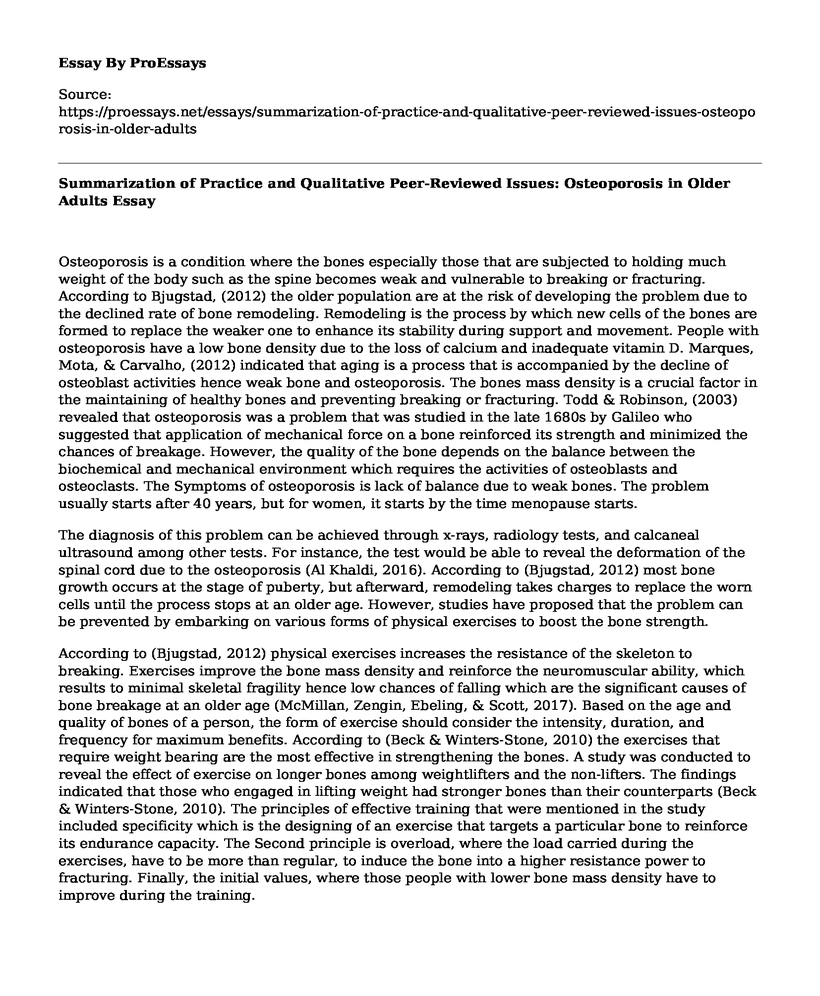Osteoporosis is a condition where the bones especially those that are subjected to holding much weight of the body such as the spine becomes weak and vulnerable to breaking or fracturing. According to Bjugstad, (2012) the older population are at the risk of developing the problem due to the declined rate of bone remodeling. Remodeling is the process by which new cells of the bones are formed to replace the weaker one to enhance its stability during support and movement. People with osteoporosis have a low bone density due to the loss of calcium and inadequate vitamin D. Marques, Mota, & Carvalho, (2012) indicated that aging is a process that is accompanied by the decline of osteoblast activities hence weak bone and osteoporosis. The bones mass density is a crucial factor in the maintaining of healthy bones and preventing breaking or fracturing. Todd & Robinson, (2003) revealed that osteoporosis was a problem that was studied in the late 1680s by Galileo who suggested that application of mechanical force on a bone reinforced its strength and minimized the chances of breakage. However, the quality of the bone depends on the balance between the biochemical and mechanical environment which requires the activities of osteoblasts and osteoclasts. The Symptoms of osteoporosis is lack of balance due to weak bones. The problem usually starts after 40 years, but for women, it starts by the time menopause starts.
The diagnosis of this problem can be achieved through x-rays, radiology tests, and calcaneal ultrasound among other tests. For instance, the test would be able to reveal the deformation of the spinal cord due to the osteoporosis (Al Khaldi, 2016). According to (Bjugstad, 2012) most bone growth occurs at the stage of puberty, but afterward, remodeling takes charges to replace the worn cells until the process stops at an older age. However, studies have proposed that the problem can be prevented by embarking on various forms of physical exercises to boost the bone strength.
According to (Bjugstad, 2012) physical exercises increases the resistance of the skeleton to breaking. Exercises improve the bone mass density and reinforce the neuromuscular ability, which results to minimal skeletal fragility hence low chances of falling which are the significant causes of bone breakage at an older age (McMillan, Zengin, Ebeling, & Scott, 2017). Based on the age and quality of bones of a person, the form of exercise should consider the intensity, duration, and frequency for maximum benefits. According to (Beck & Winters-Stone, 2010) the exercises that require weight bearing are the most effective in strengthening the bones. A study was conducted to reveal the effect of exercise on longer bones among weightlifters and the non-lifters. The findings indicated that those who engaged in lifting weight had stronger bones than their counterparts (Beck & Winters-Stone, 2010). The principles of effective training that were mentioned in the study included specificity which is the designing of an exercise that targets a particular bone to reinforce its endurance capacity. The Second principle is overload, where the load carried during the exercises, have to be more than regular, to induce the bone into a higher resistance power to fracturing. Finally, the initial values, where those people with lower bone mass density have to improve during the training.
Conclusion
In conclusion, osteoporosis is a problem that affects the older people and starts after the age of 40 years and for women during menopause. At this age bone remodeling activities have declined hence increased the risk for bone fragility. However, physical exercises can be used to boost bone mass density hence its strength which will prevent osteoporosis from occurring.
References
Al Khaldi, M. (2016). Exercise Intervention for Osteoporosis Prevention in Postmenopausal Women: A Systematic Review. J Nov Physiother, 7(323), 2. Retrieved from https://pdfs.semanticscholar.org/389d/84381250523e91676135f86b6f1e5a884f90.pdf
Bjugstad, K. (2012). The Role of physical activity as prevention against osteoporosis (Master's thesis). Retrieved from https://www.duo.uio.no/bitstream/handle/10852/29170/Innlevering.pdf?sequence=1
Beck, B. R., & Winters-Stone, K. M. (2010). Exercise in the prevention of osteoporosis-related fractures. In
Osteoporosis(pp. 207-239). Humana Press. Retrieved from https://research-repository.griffith.edu.au/bitstream/handle/10072/33254/59505_1.pdf?sequence=1Marques, E. A., Mota, J., &
Carvalho, J. (2012). Exercise effects on bone mineral density in older adults: a meta-analysis of randomized controlled trials. Age, 34(6), 1493-1515. Retrieved from https://www.ncbi.nlm.nih.gov/pmc/articles/PMC3528362/
McMillan, L. B., Zengin, A., Ebeling, P. R., & Scott, D. (2017, November). Prescribing Physical Activity for the Prevention and Treatment of Osteoporosis in Older Adults. In Healthcare (Vol. 5, No. 4, p. 85). Multidisciplinary Digital Publishing Institute.
Todd, J. A., & Robinson, R. J. (2003). Osteoporosis and exercise. Postgraduate Medical Journal, 79(932), 320-323. Retrieved from https://pdfs.semanticscholar.org/0640/09b0f9a658c17fec69b258187c6e52f9bec0.pdf
Cite this page
Summarization of Practice and Qualitative Peer-Reviewed Issues: Osteoporosis in Older Adults. (2022, Apr 04). Retrieved from https://proessays.net/essays/summarization-of-practice-and-qualitative-peer-reviewed-issues-osteoporosis-in-older-adults
If you are the original author of this essay and no longer wish to have it published on the ProEssays website, please click below to request its removal:
- Nutrient and Physical Activity Analysis Project
- Accreditation Audit: Assuring the Transfer of Accurate Patient Information
- What Is the Best Way to Reduce Postoperative Questions and Shorten Hospital Stay in Surgical?
- Paper Example on Ventilator-Associated Pneumonia: Risk and Prevalence
- Essay on AACN Research Results: Diabetes and Cancer Rate Increase With Globalization
- Essay Sample on COVID-19: Impact on Supply Chain Management & Strategies for Recovery
- Essay Example on Language Barrier Overcome: My Most Notable Nursing Experience







